No products in the cart.
One species you can plant outdoors as a security or street tree is the honey locust tree (Gleditsia triacanthos). This medium-sized tree can reach a height of 80 to 100 feet tall and is known to be very hardy.
A native of central and eastern North America, you’ll see honey locust trees scattered in bottomlands along streams, valley areas, upland slopes, and open or wooded pastures.
The thorns of honey locusts are why it’s not so much used in a garden, unlike many other landscape trees. Some even consider it a weed. But luckily today, there are thornless honey locust trees available that are more suited for urban planting.
Below is more extensive information to know more about honey locust trees.
More About Honey Locust Tree

A deciduous tree species belonging to the Fabaceae family, the honey locust is one of the fast-growing trees with graceful foliage and edible pulp from its seed pods. These seed pods are important to wildlife because it serves as food for white-tailed deer, raccoons, rabbits, and squirrels.
Honey locust is called by many names including Common Honey Locust, Honey Shucks Locust, Sweet Bean Tree, Sweet Locust, or Thorny Locust. But all of these common names refer to the same species, Gleditsia triacanthos.
The crown of the honey locust is open and can cover a diameter of 25 to 30 feet. It’s a good lawn tree because it won’t provide a dense shade, allowing the turf grasses and other well-known landscape plants below to benefit from the sunlight.
In terms of branching pattern, its foliage resembles that of a bird feather. Smaller leaflets that are oval in shape branch out from the main seam. These leaves boast a dark green color that eventually turns bright yellow during the early Fall season.
Because sweet locust is deciduous, lose their leaves, revealing their upright, branching, and sophisticated silhouette.
In addition, it also produces flowers that are very attractive to pollinating agents because they’re fragrant. Appearing in greenish-yellow colors, these flowers hang in clusters of about 3 to 5 inches long. Blooming starts in late spring and lasts until early summer (May to June).
Pollinated flowers develop into a compressed, flattened, and leathery pod which turns brow and twisted once mature.
The trunk and branches of this tree are covered by thorns that are about 3 inches long, which becomes a major challenge when it comes to management.
Honey Locust Tree Care
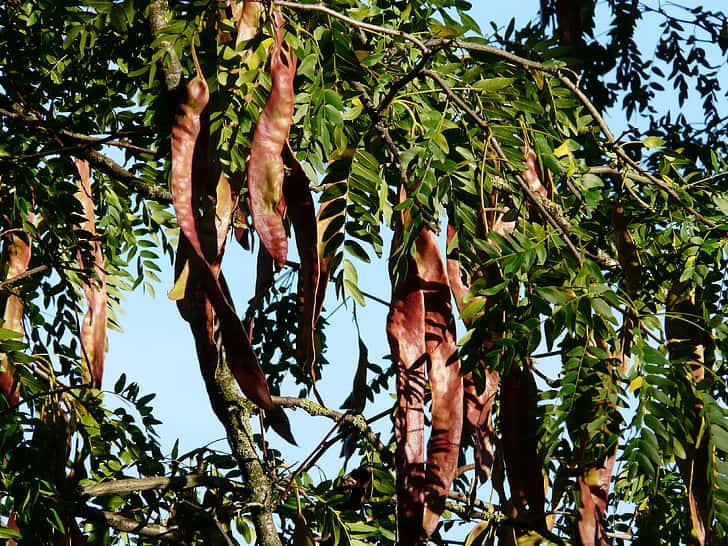
Once established, honey locusts will require very little maintenance. This super hardy tree will withstand harsh conditions such as drought and pollution. But if you’re planning to grow this tree for the first time, here are the basic requirements to fulfill.
Soil
The soil preference of honey locusts includes the following properties: moist, fertile, and alluvial. The best plant soil would be soil that’s rich in organic matter but it will also grow in other soil types. It thrives in a wide range of soil pHs from acidic to alkaline soils.
Light
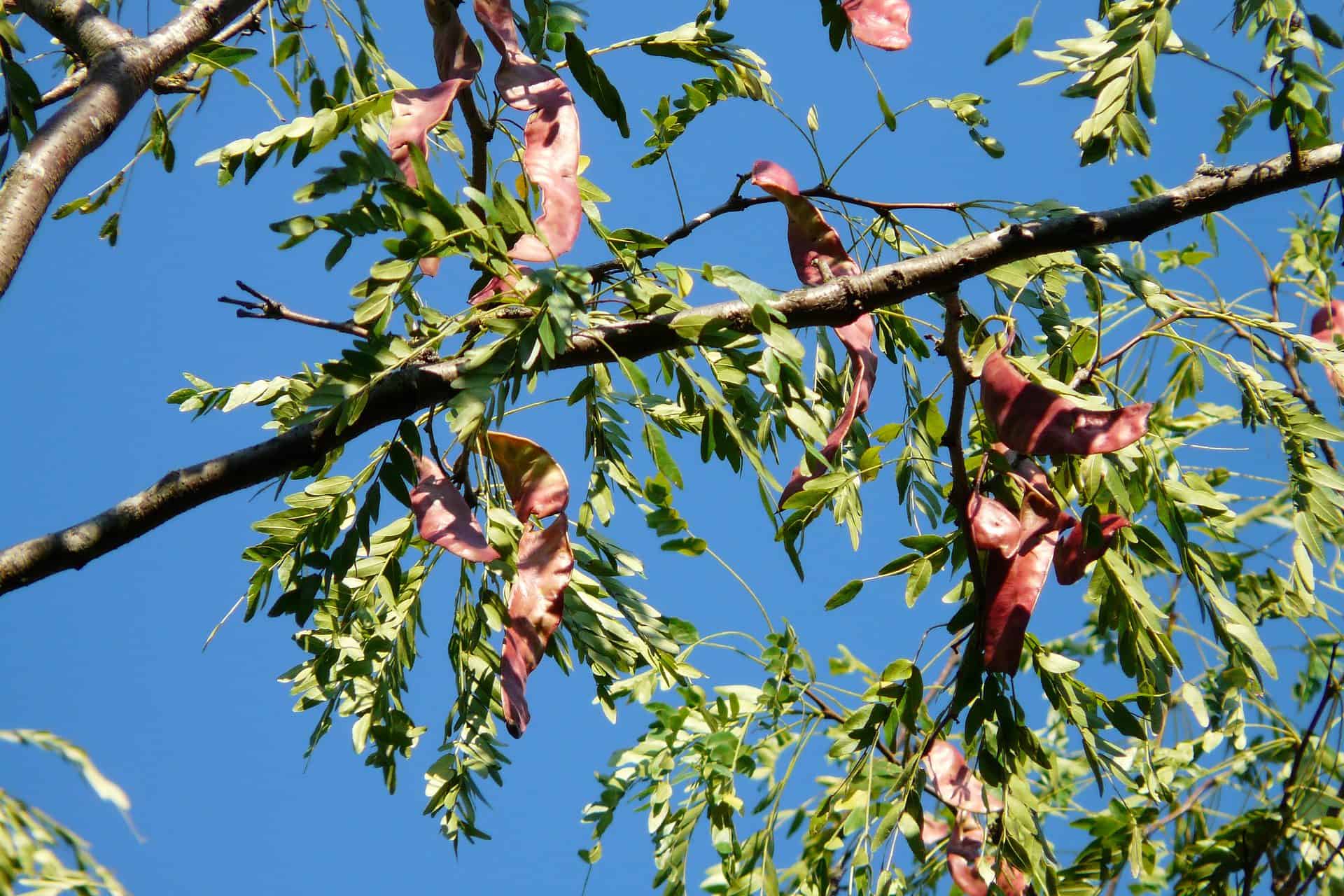
Locations that have access to the full sun are ideal. Honey locust trees will enjoy exposure to six or more hours of sunlight daily. Partial shade is also tolerable but make sure they receive at least two to six hours of direct sunlight.
Deep shade or filtered shade is not recommended.
Water
Locust trees are pretty resilient they’ll do well either in moist or dry soil. For young trees, adequate watering is needed so they’ll establish a good, deep root system. Water honey locusts weekly for a year after planting.
Keeping the tree well-watered at this stage is critical because they’re undergoing a lot of growth and development.
Remember to keep the soil moist but not overly saturated. Mature honey locust trees will be moderately resistant to drought so there’s no need to water them that often.
Temperature & Humidity
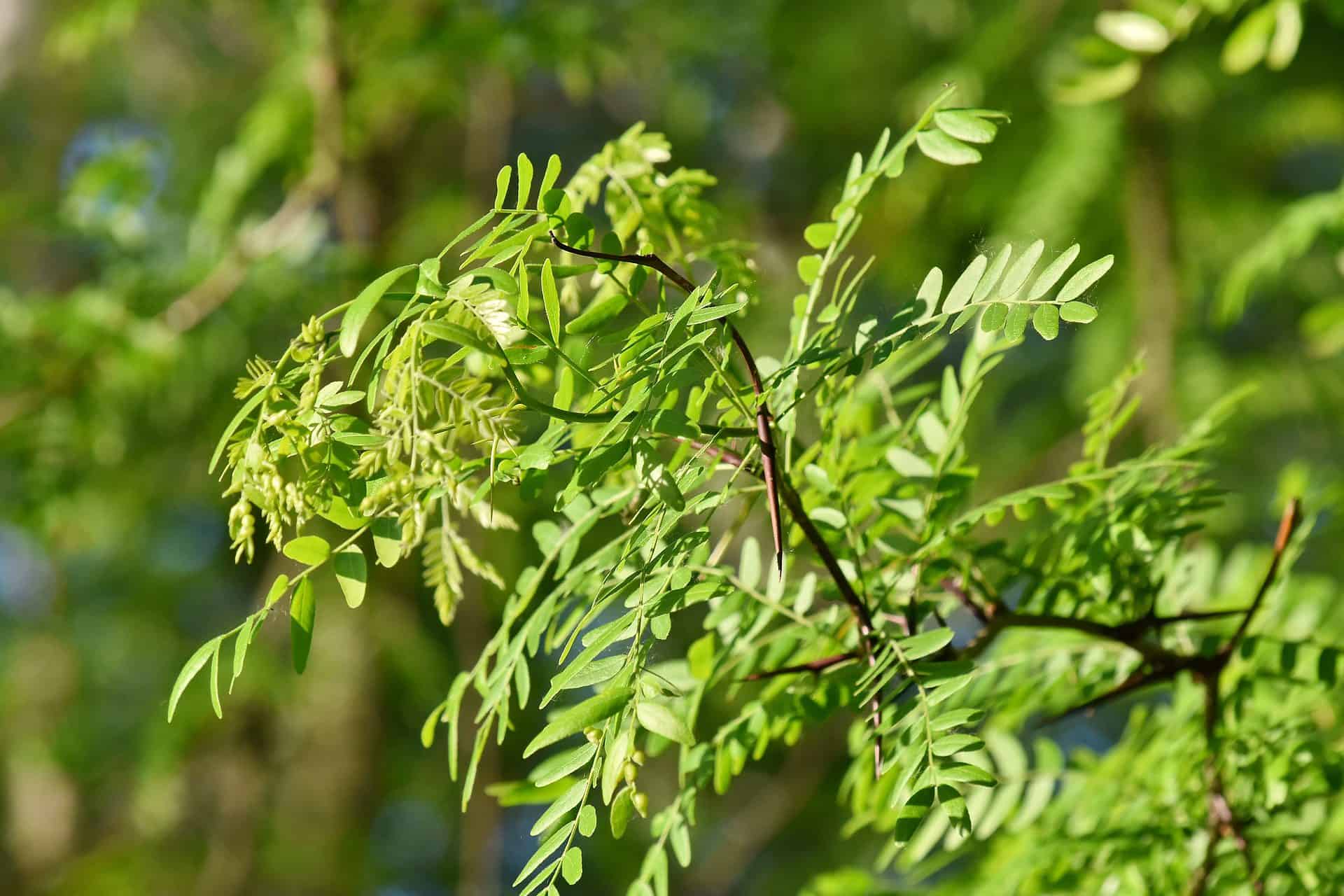
This tree will thrive in USDA hardiness zones 4 to 9, as they give the most favorable climate for the Gleditsia triacanthos tree to grow and flourish. You’ll find it heavily distributed in central America.
A temperature below -30°F (-34.44°C) will be detrimental to this tree and may cause death.
Fertilizer

Older trees rarely need additional fertilizer, especially if planted in a fertilized lawn. But for a young tree, there’ll be a need to apply supplementary sources of nutrients either a fast-release or slow-release fertilizer. Make sure the soil is well-irrigated after fertilizer application.
Pruning
You’ll need to remove dead and damaged branches, thus, pruning is required from time to time. Take extra caution when doing so because the trunk and branches are thorny. The best time to prune is during the fall season after the leaves have dropped or early spring before the sap flow resumes.
For a young tree, pruning is required every five years to boost growth and shape the tree to the desired form. Pruning is also critical to remove diseased branches that may possibly spread to other parts.
Propagation

The use of honey locust seeds is the most prevalent way of propagating this tree. Because the seeds have impermeable seed coats, they remain viable for a long period. If you decide to use seeds for propagation, you’ll need to extract good seeds from the bean pods and conduct stratification.
Stratification is the process of subjecting the seeds to boiling water to destroy the seed coats and make them permeable. After cooling down, the treated seeds are planted in a high-quality potting mix. Seeds germinate well through this method.
Vegetative propagation such as cutting, grafting, and budding of hardwood, softwood, and roots can also be done.
Honey Locust Similar Trees
Black Locust (Robinia pseudoacacia)

The black locust is a tree species that have large clusters of showy white flowers. It also has thorns, pods, and leaves but they’re highly poisonous.
Thornless Honey Locust (Gleditsia triancanthos var. Inermis)
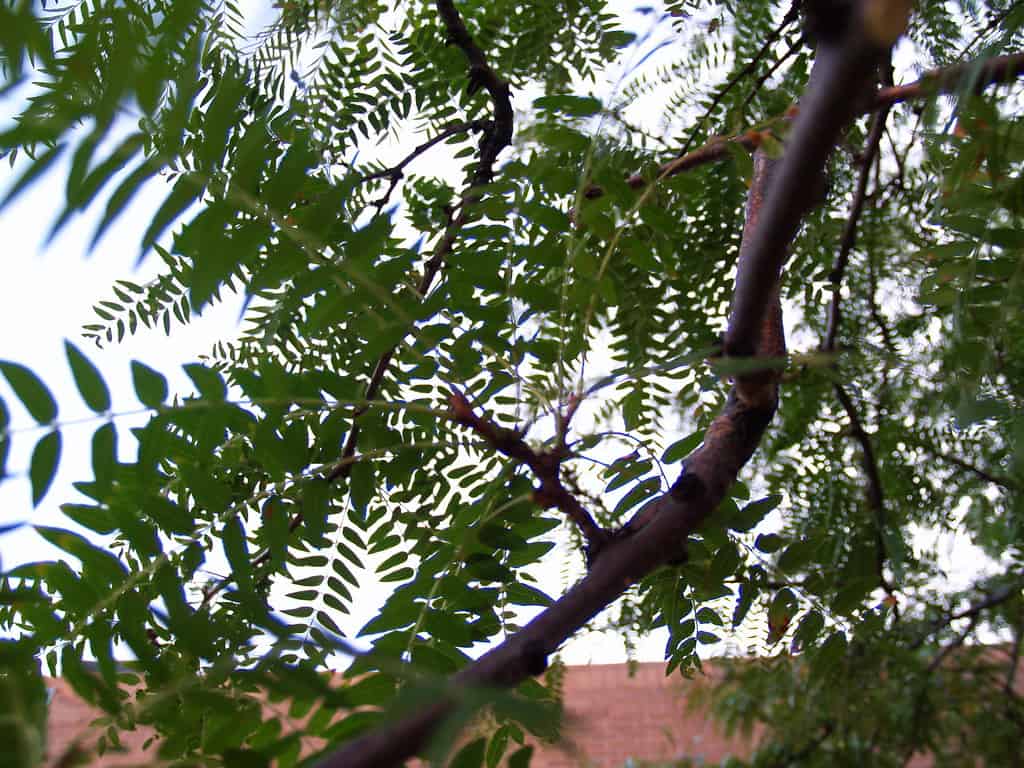
Inermis is a thornless variety of the Gleditsia triancanthos. It looks almost the same as the original honey locust, except that it has no nasty thorns and the bean pods are elongated. This variety is commonly used in urban areas.
Japanese Locust (Gleditsia japonica)
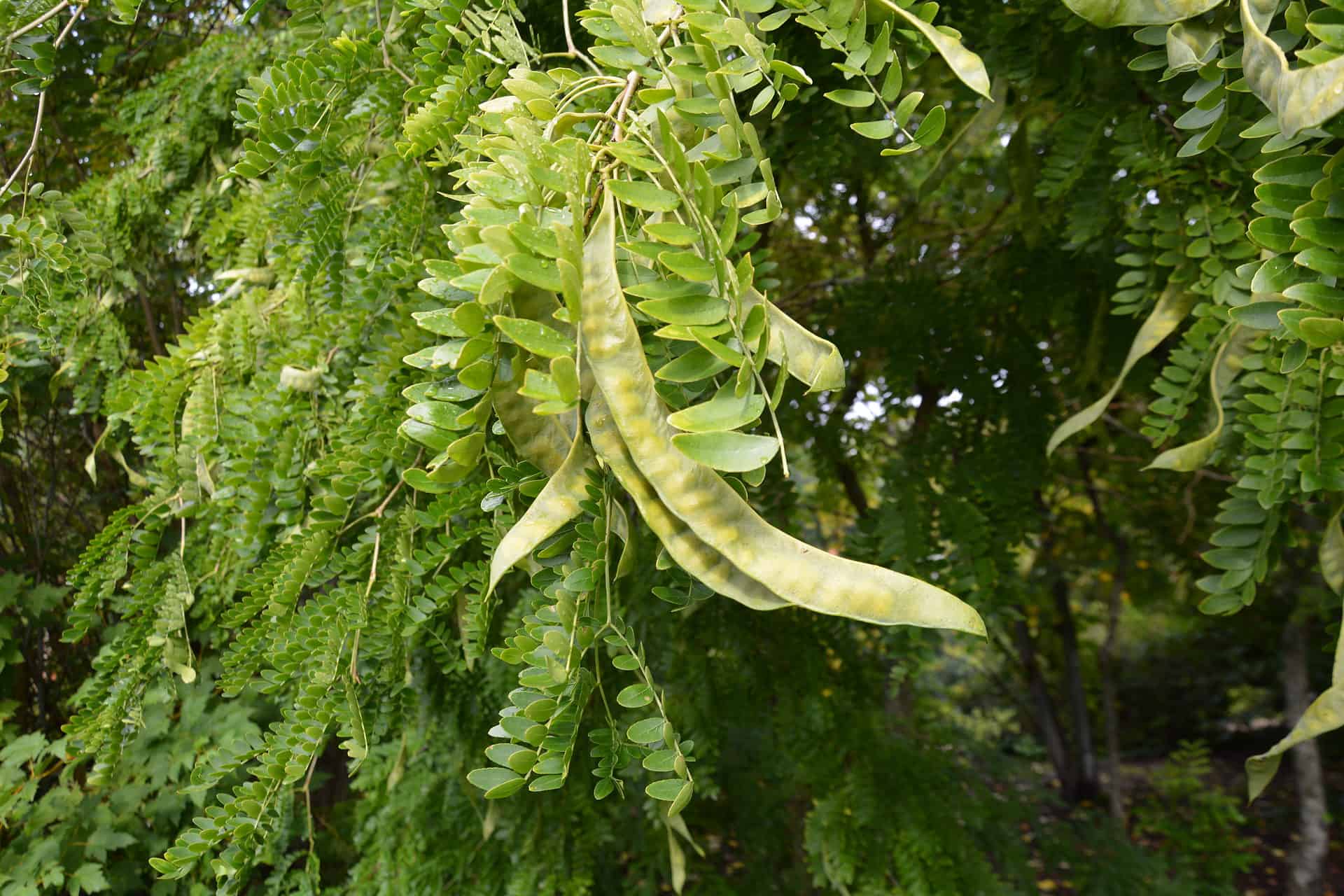
This species is native to Japan. It’s also deciduous and can reach a mature size of 65 feet tall. The trunk has 10-inch long thorns that can be dangerous. The pods are also edible. Japanese also roast the seeds and eat them with sugar.
Honey Locust Common Diseases And Pests
Insect pests like spider mites, borers, webworms, and locust leafminers can be a problem for honey locusts. You can use some organic sprays or insecticides to get rid of their huge population if there is one.
Common diseases include leaf spot, canker, witches’ broom, powdery mildew, and rust.
Frequently Asked Questions
Honey locusts are fast-growing trees. They grow an average of two feet or more each year for the next ten years.
The average lifespan of Gleditsia triacanthos is 125 years. Seed bearing starts when the tree is 10 years old and reaches an optimum production between 25 to 75 years of age.
The flower clusters of mature trees are very fragrant, making them highly attractive to pollinating insects.
Plantly has a collection of trees and bushes where you can choose tree specimens for your garden.
Whether you want to buy, sell or simply reach out to other plant enthusiasts, Plantly is the right place to be!


